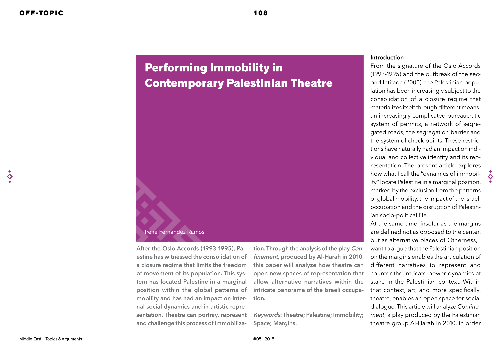Performing Immobility in Contemporary Palestinian Theatre
After the Oslo Accords (1993-1995), Palestine has witnessed the consolidation of a closure regime that limits the freedom of movement of its population. This system has located Palestine in a marginal position within the global patterns of mobility and has had an impact in the internal social dynami...
I tiakina i:
| I whakaputaina i: | Middle East - Topics & Arguments |
|---|---|
| Kaituhi matua: | |
| Hōputu: | Artikel (Zeitschrift) Daten |
| Reo: | Ingarihi |
| I whakaputaina: |
Philipps-Universität Marburg
2015
|
| Ngā marau: | |
| Urunga tuihono: | Tiro pūkete Urunga tuihono |
| Tags: |
Tag hinzufügen
Keine Tags, Fügen Sie den ersten Tag hinzu!
|
| Whakarāpopototanga: | After the Oslo Accords (1993-1995), Palestine has witnessed the consolidation of a closure regime that limits the freedom of movement of its population. This system has located Palestine in a marginal position within the global patterns of mobility and has had an impact in the internal social dynamics and in artistic representation. Theatre can portray, represent and challenge this process of immobilization. Through the analysis of the play Confinement, produced by Al-Harah in 2010, this paper will analyze how theatre can open new spaces of representation which allows alternative narratives within the intricate panorama of the Israeli occupation. |
|---|---|
| DOI: | 10.17192/meta.2015.5.3430 |
 Publikationsserver
Publikationsserver